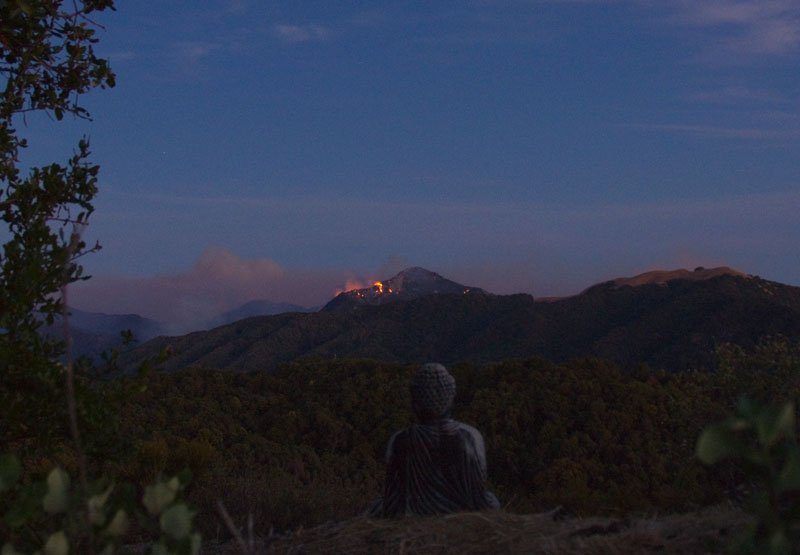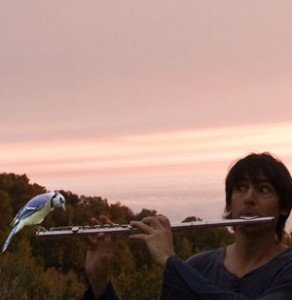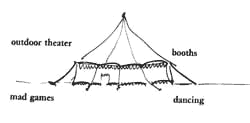While we all known plants convert carbon dioxide into oxygen through photosynthesis, NASA’s 1989 study showed that many houseplants also remove harmful elements such as amonia, trichloroethylene, benzene, and formaldehyde from the air – how elegant is that!?

image from www.naturaire.com
In researching how to create a breathable environment for NASA orbiting space stations, scientist Dr. Bill Wolverton discovered that houseplants are the best filters of common pollutants – chemicals released by furniture, carpets, synthetic and treated building materials, photocopiers, and all manner of other toxic crap born out of inelegant chemistry and consumptive in-dust-reality, leading to a host of dis-ease, respiratory and allergic problems.
Newer homes and buildings, designed for energy efficiency, tend to be tightly sealed to avoid energy loss from heating and air conditioning systems, trapping VOC’s and creating poor IAQ
“Palms and ferns are among the best filters,” says Bill C. Wolverton, “Spider plants are also excellent because they target benzene, the chemical released from house paint.”
Plants, as the lungs of the earth
Plants produce the oxygen that makes life possible, add precious moisture, and filter toxins. Houseplants can perform these essential functions in the home or work place with the same efficiency as a rainforest in our biosphere. Read that again!
The advantage that houseplants have in particular is that they evolved in tropical or sub-tropical forests, where they received light filtered through the branches of taller trees. Their leaf composition allows them to photosynthesize more efficiently under relatively low light conditions, which in turn allows them to process gasses in the air efficiently.
Unlike man-made filters that absorb toxins like a sponge—and ultimately end up in the landfill—plants break toxins apart, says Wolverton. Plants suck air into the ground, where microbes degrade toxins into fundamental sources of energy and life. and therein lies an example of an elegant solutions to model our own industrial chemical processes on – green chemistry and biomimicry are the progressive forefront of a solutions oriented movement to this end.
[See: How to Grow Clean Air – 50 House Plants that Purify Your Home or Office, by B. C. Wolverton]
Recent Studies
In a new study from the University of Technology in Sydney, Australia, biologist Margaret C. Burchett and colleagues tested the impact of two plants, the Spathiphyllum “peace lily” and the “Janet Craig” Dracaena on air quality in 60 different offices. After 18 weeks of measurements, the findings were striking: As few as six small potted plants reduced overall toxin levels by 75 percent.
“The most remarkable finding is that the plants seemed to ramp up their filtration abilities when the air was more toxic,” says Burchett. She found houseplants were better filters during weeks when pollution levels were high, and performance waned when the air was more pure. Overall, offices with plants had cleaner air than those left without the additional splash of green.
According to a Washington State University study, houseplants also reduce stress and help people relax. Plants have been shown to increase employee productivity, reduce sick leave rates by as much as 60 percent, and heighten a patient’s ability to tolerate pain and physical discomfort. Installations of indoor plants have been shown to help control temperature and humidity as well.
Wolverton recommends adding a few plants to each room, but to see a drastic improvement, Wolverton argues houseplants have to be used as a technology platform.
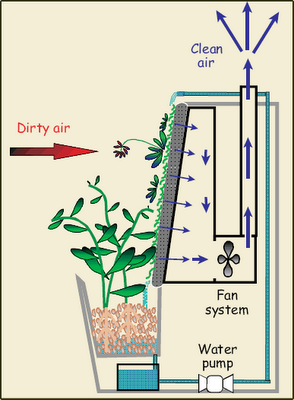
image from www.manhattanplant.com
From rooftop ecology gardens to greenhouse window boxes that circulate filtered air, Wolverton says houseplants have the most impact when they are literally planted into the house. Wolverton has also designed an EcoPlanter, which claims to more than double a plant’s filtration capacity through the use of activated carbon, and has been marketed in Japan for nearly a decade. Phytofilter, a startup based in Saratoga Springs, New York, recently licensed the exclusive rights to Wolverton’s research and technology, and hopes to integrate large planters into the ventilation systems of buildings and apartment complexes by 2010.
Living Walls and Biofiltration
The landscape+urbanism blog and naturaire.com say:
living wall biofiltration involves a hybrid of two technologies: “… biofiltration, the use of biological systems of beneficial microbes to break organic pollutants down into their benign constituents, and phyto-remediation, the use of green plants to facilitate the remediation or reclamation of contaminated soils or water.”
Unlike mechanical filters which clog or saturate, plants are self-rejuvenating: “Because the pollutants in the air are broken down to their benign constituents, there is nothing to accumulate in the system.”
Plants are beneficial in other ways, by a variety of means. These include, a high surface area ratio, they are regenerative, can actively break down microbes versus merely filtering – both in vegetation and roots, accumulate airborne pollutants and dust, and provide a CO2 sink via photosynthesis.
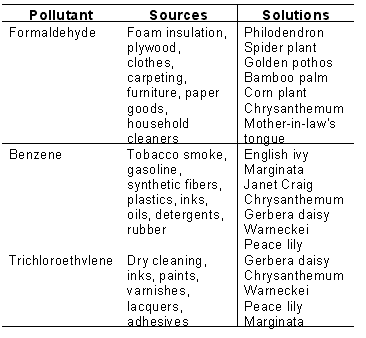 While NASA found that some of the plants were better than others for absorbing these common pollutants, all of the plants had properties that were useful in improving overall indoor air quality. NASA also noted that some plants are better than others in treating certain chemicals. For example, English ivy, gerbera daisies, pot mums, peace lily, bamboo palm, and Mother-in-law’s Tongue were found to be the best plants for treating air contaminated with Benzene. The peace lily, gerbera daisy, and bamboo palm were very effective in treating Trichloroethylene. Additionally, NASA found that the bamboo palm, Mother-in-law’s tongue, dracaena warneckei, peace lily, dracaena marginata, golden pathos, and green spider plant worked well for filtering Formaldehyde. After conducting the study, NASA and ALCA came up with a list of the most effective plants for treating indoor air pollution.
While NASA found that some of the plants were better than others for absorbing these common pollutants, all of the plants had properties that were useful in improving overall indoor air quality. NASA also noted that some plants are better than others in treating certain chemicals. For example, English ivy, gerbera daisies, pot mums, peace lily, bamboo palm, and Mother-in-law’s Tongue were found to be the best plants for treating air contaminated with Benzene. The peace lily, gerbera daisy, and bamboo palm were very effective in treating Trichloroethylene. Additionally, NASA found that the bamboo palm, Mother-in-law’s tongue, dracaena warneckei, peace lily, dracaena marginata, golden pathos, and green spider plant worked well for filtering Formaldehyde. After conducting the study, NASA and ALCA came up with a list of the most effective plants for treating indoor air pollution.
Recommended plants
The NASA studies generated the recommendation that you use 15 to 18 good-sized houseplants in 6 to 8-inch diameter containers to improve air quality in an average 1,800 square foot house. The more vigorously they grow, the better job they’ll do for you.
Soil and roots were also found to play an important role in removing air-borne pollutants. Micro-organisms in the soil become more adept at using trace amounts of these materials as a food source, as they were exposed to them for longer periods of time. Their effectiveness is increased if lower leaves that cover the soil surface are removed, so there is as much soil contact with the air as possible.
- Philodendron scandens `oxycardium’, Heartleaf philodendron
- Philodendron domesticum, Elephant ear philodendron
- Dracaena fragrans `Massangeana’, Cornstalk dracaena
- Hedera helix, English Ivy
- Chlorophytum comosum, Spider plant
- Dracaena deremensis `Janet Craig’, Janet Craig dracaena
- Dracaena deremensis `Warneckii’, Warneck dracaena
- Ficus benjamina, Weeping Fig
- Epipiremnum aureum, Golden pothos
- Spathiphyllum `Mauna Loa’, Peace lily
- Philodendron selloum, Selloum philodendron
- Aglaonema modestum, Chinese evergreen
- Chamaedorea sefritzii, bamboo or reed palm
- Sansevieria trifasciata, Snake plant
- Dracaena marginata , Red-edged dracaena
- Gerbera jamesonii, Gerbera Daisy
- Chrysantheium morifolium, Pot Mum
- Ficus elastica, Rubber Plant

image from www.good.is – click image to enlarge
Like this:
Like Loading...









